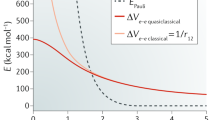Abstract
The intrinsic reactivity of cyanide when interacting with a silver cation was rationalized using the dual descriptor (DD) as a complement to the molecular electrostatic potential (MEP) in order to predict interactions at the local level. It was found that DD accurately explains covalent interactions that cannot be explained by MEP, which focuses on essentially ionic interactions. This allowed the rationalization of the reaction mechanism that yields silver cyanide in the gas phase. Other similar reaction mechanisms involving a silver cation interacting with water, ammonia, and thiosulfate were also explained by the combination of MEP and DD. This analysis provides another example of the usefulness of DD as a tool for gaining a deeper understanding of any reaction mechanism that is mainly governed by covalent interactions.

The dual descriptor adapted to molecular symmetry reveals which atom of cyanide ligand, carbon or nitrogen, will react more favorably with a silver atom in the silver cyanide complex






Similar content being viewed by others
References
Politzer P, Murray JS (2002) Theor Chem Acc 108:134–142
Murray JS, Politzer P (2011) The electrostatic potential: an overview. WIREs Comput Mol Sci 1:153–163
Hohenberg P, Kohn W (1964) Phys Rev B 136:864–871
Kohn W, Sham LJ (1965) Phys Rev A 140:1133–1138
Geerlings P, De Proft F, Langenaeker W (2003) Chem Rev 103:1793–1873
Chermette H (1999) J Comput Chem 20:129–154
Morell C, Grand A, Toro-Labbé A (2005) J Phys Chem A 109:205–212
Morell C, Grand A, Toro-Labbé A (2006) Chem Phys Lett 425:342–346
Toro-Labbé A (2007) Theoretical aspects of chemical reactivity, vol 19. Elsevier, Amsterdam
Ayers PW, Morell C, De Proft F, Geerlings P (2007) Chem Eur J 13:8240–8247
Morell C, Ayers PW, Grand A, Gutiérrez-Oliva S, Toro-Labbé A (2008) Phys Chem Chem Phys 10:7239–7246
Morell C, Hocquet A, Grand A, Jamart-Grégoire B (2008) THEOCHEM 849:46–51
Cárdenas C, Rabi N, Ayers PW, Morell C, Jaramillo P, Fuentealba P (2009) J Phys Chem A 113:8660–8667
Fuentealba P, Parr RG (1991) J Chem Phys 94:5559–5564
Parr RG, Yang W (1989) Density-functional theory of atoms and molecules. Oxford University Press, New York, pp 95–97
Flores-Moreno R (2010) J Chem Theory Comput 6:48–54
Martínez J (2009) Chem Phys Lett 478:310–322
Martínez JI, Moncada JL, Larenas JM (2010) J Mol Model 16:1825–1832
Schlegel HB (1982) J Comput Chem 3:214–218
Becke AD (1988) Phys Rev A 38:3098–3100
Becke AD (1993) J Chem Phys 98:5648–5652
Becke AD (1993) J Chem Phys 98:1372–1377
Lee CL, Yang W, Parr RG (1988) Phys Rev B 37:785–789
Jeffrey Hay P, Wadt WR (1985) J Chem Phys 82:270–283
Jeffrey Hay P, Wadt WR (1985) J Chem Phys 82:299–310
Frisch MJ et al (2010) Gaussian 09, revision B.1. Gaussian, Inc., Wallingford
Pearson RG (1963) J Am Chem Soc 85:3533–3543
Pearson RG, Songstad J (1967) J Am Chem Soc 89:1827–1836
Pearson RG (1968) J Chem Educ 45:581–587
Pearson RG (1987) J Chem Educ 64:561–567
Gázquez JL (1997) J Phys Chem A 26:4657–4659
Acknowledgments
This work was partially financed by funding from the Vice-Rector of Research and Development to promote and support research in the UPV university community, so the author wishes to thank the financial support afforded by Fondo VRID no. 000012A26 (Fondo Vicerrectoría de Investigación y Desarrollo) from UPV and FONDECYT grant no. 11100070 (A Project for Research Initiation), which provided computational equipment and software.
Author information
Authors and Affiliations
Corresponding author
Rights and permissions
About this article
Cite this article
Martínez-Araya, J.I. Explaining reaction mechanisms using the dual descriptor: a complementary tool to the molecular electrostatic potential. J Mol Model 19, 2715–2722 (2013). https://doi.org/10.1007/s00894-012-1520-2
Received:
Accepted:
Published:
Issue Date:
DOI: https://doi.org/10.1007/s00894-012-1520-2




